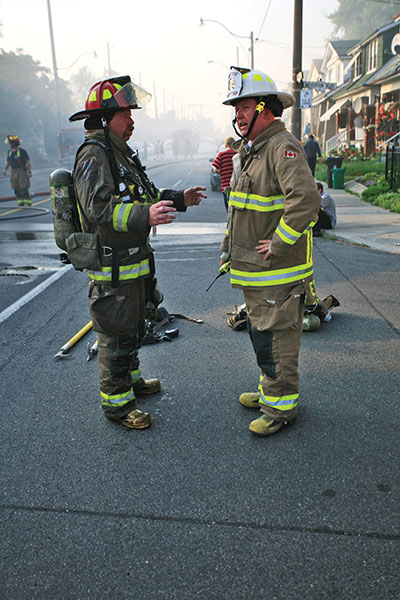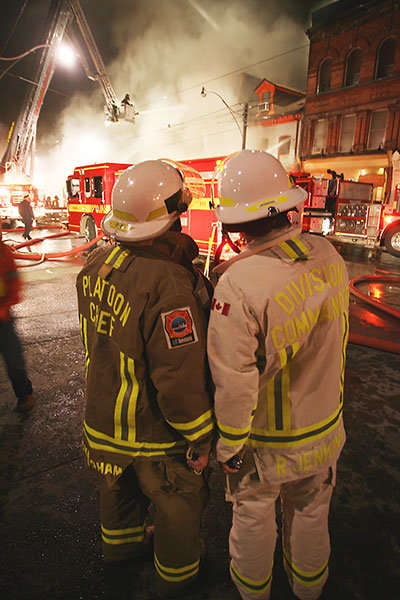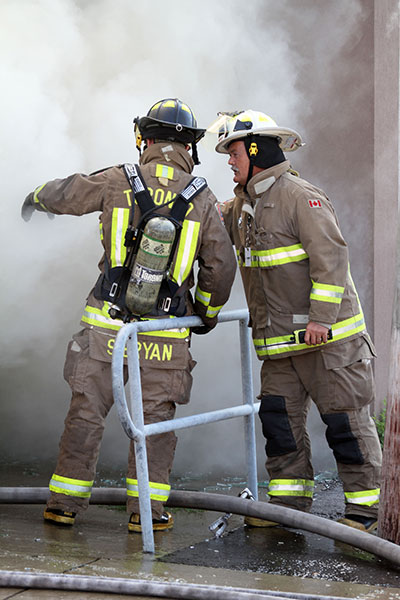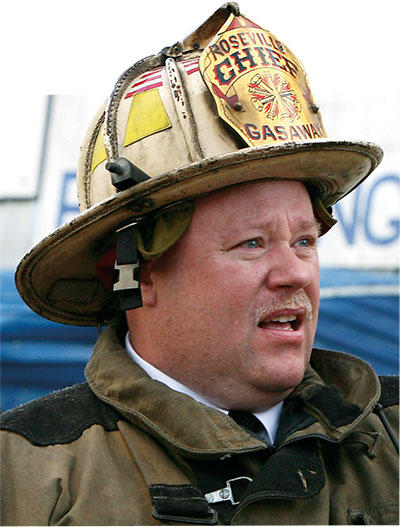
Features
Training
Fire-ground decision making
In the May issue of Fire Fighting in Canada I wrote about situational awareness. Now, we’ll look at the importance of decision making as it relates to situational awareness.
November 22, 2013
By Richard Gasaway
In the May issue of Fire Fighting in Canada I wrote about situational awareness. Now, we’ll look at the importance of decision making as it relates to situational awareness. After all, the decisions we make, based on our situational awareness, drive successful (or unsuccessful) outcomes.
 |
|
| The decision-making process on the fire ground must account for stress. Focus on the most relevant information and try to detect unusual situations that may affect the outcome of your actions. Photos by John Riddell
|
The traditional and longstanding belief is that a good decision is best made by following a rational, analytical and non-emotional process. Thankfully, such a process has long been defined and taught. These are the steps for good decision making:
- Define the problem.
- Identify decision-making criteria.
- Allocate weights and measures to the various criteria.
- Develop some alternatives to consider.
- Evaluate the various alternatives.
- Select the best or highest ranked alternative.
- Evaluate the decision’s effectiveness.
This is a very solid decision-making model – if you want to buy a house or make a strategic decision in your business. However, before you copy this list, laminate it, and put it in the pocket of your turnout coat, there’s something you should know: this model doesn’t work well at emergency scenes.
To understand why, let’s take a brief look at brain anatomy and function. The human brain has two halves, which are formally known as hemispheres.
Your left hemisphere is your rational brain. If you’re great at math, enjoy using spreadsheets and tend to plan out every detail to the highest degree, then you are a predominately left-brained person.
Your right hemisphere is your creative brain. If you’re great with art, music and making vacation plans on the fly, and your living space is far less than orderly (OK – it’s downright messy!), then you are predominately a right-brained person.
Both hemispheres are used in the process of making good and bad decisions. In fact, it would not be possible to turn off the influence of either side of your brain. How-ever, stress can influence brain behaviour, and impact the way you think, decide and act. More specifically, stress related to threats that endanger your survival affect the decisions you make. This is precisely the environment in which first responders operate. It is important to understand your stressed brain doesn’t function the same way as your non-stressed brain. This means you will think, and act, differently when you are under incident-scene stress than you will in a relaxed environment.
Your brain recognizes when you experience threat-related stress and sends out alert messages. Your body then reacts to that message by releasing chemicals that prepare you biologically, emotionally, psychologically and physically to deal with
the threat.
The way you deal with threats, including how you make decisions, is engrained in your DNA. Since the early existence of our species, the brain has been learning (and remembering) how to make decisions in high-stress, high-consequence environments. Through millions of years of evolution, our species has learned how to make good decisions and survive. Those same hereditary instincts for how to make split-second decisions are within you.
When you experience stress, your rational left brain becomes less active and your intuitive right brain picks up the slack. In fact, in a high-stress, high-consequence decision-making environment, your right brain dominates. And this is where the previously mentioned decision-making model falls apart. That model is based on rational, analytical, non-emotional facts that drive the decision. Those are all left-brain functions.
Under stress, the right brain dominates and the decision making becomes more creative, intuitive and, much to the chagrin of some who would prefer otherwise, emotional. Yes, high-stress, high-consequence decisions are highly influenced by emotions. In fact, very strong arguments (backed by research) support the idea that all decisions, regardless of stress and consequence, are influenced heavily by emotions.
If the traditional, rational, analytical decision-making process does not work well under stress, then how are decisions made? They are made using a dynamic, intuitive process that taps into the power of the right brain. The body of research that supports intuitive decision making by firefighters was started more than 25 years ago when a researcher named Gary Klein was working on a project to help the United States military improve decision making on battlefields. Klein’s work uncovered a new model for decision making in high-stress, high-consequence, dynamically changing environments. He called it the recognition-primed decision-making process. I have taken the liberty of adapting Klein’s finding to help first responders understand how to improve incident-scene decision making. Here are the steps of the dynamic decision making process:
- Conduct a rapid size-up.
- Focus on the most relevant information.
- Recognize typical ways in which you would deal with the situation.
- Run through the options in your mind.
- Form expectations about the outcomes.
- Detect unusual problems and seek explanations for odd things.
- Make a plan and put the decision into action.
Let’s look at each of the steps of the dynamic decision-making process to see how firefighters can use them to help improve decision making at incident scenes.
Conduct a rapid size-up
In a dynamic environment where things are changing fast, the size-up needs to be quick. When I discuss this with firefighters, some believe the incident scene size-up must be quick because the situation requires rapid action to prevent further damage or loss of life. While this may be true in many instances, it is not the reason the decision-making process demands a rapid size-up. A quick size-up is necessary because the speed at which things are changing can cause the decision maker to become overwhelmed with information.
 |
|
| Stress can influence brain behaviour, and impact the way you think, decide and act. More specifically, stress related to threats that endanger your survival affects the decisions you make.
|
Remember this: under stress the rational brain isn’t functioning well, and it is the rational brain that processes information. This means that high volumes of information, and complex and detailed information, are not your friends under stress. In fact, they can be detrimental to decision making. When the brain cannot figure out what is going on, it can lock up and you may not be able to make a decision at all. This is sometimes referred to as analysis paralysis. It happens when the brain is trying so hard to process and analyze volumes of information that it becomes paralyzed.
A rapid size-up ensures that the decision maker is taking only a snapshot of information. This helps to prevent the brain from becoming overloaded. In a dynamically changing environment, the longer you wait, the more information there is to comprehend. This is not to say the size-up should be cut short or left incomplete. A 360-degree size-up from which you
gather critical information to form situational awareness is imperative to making a good decision.
Focus on the most relevant information
In a dynamically changing, complex environment, such as a structure fire, there may be dozens, if not hundreds, of pieces of information coming at you. Your brain cannot process all that information. The capacity of your short-term or working memory is about seven pieces of unrelated information – not dozens or hundreds. If you try to remember more, you will forget. But what will you forget?
People who do not understand how the brain functions under stress believe the least important information will be forgotten and the most important information will be retained. This is not the case. Under stress, the brain is not very good at prioritizing important from unimportant information. Further, when a lot of information is flooding into your brain, you have little conscious control over what you will remember
or forget.
It is entirely possible that the most important things you need to remember are forgotten and the least important things are remembered. This is just the opposite of what you would want to happen. What is most likely to stick in your short-term memory is information that is familiar to you based on past training and experience, and information that triggers some emotional response or has some emotional connection with your past experiences.
If those things are among the most important, you will remember them. If they’re not very important, you will still remember them. The best thing you can do to manage the limitations of your short-term memory is write down the important things on paper. That way, if your brain gets overloaded and starts shedding important information, you have captured the most pertinent facts in writing.
Recognize typical ways to deal with the situation
As you gain experience, you learn what to expect at emergency scenes. As you prepare for and respond to an emergency, you are gathering and processing information shared with you by the dispatcher. As you form mental images in your mind about the call to which you are responding, you think back to past training and your experiences at similar calls. This helps you prepare, in advance of your arrival, and to form some expectations of what you will see.
This process allows you to quickly assess and compare the current event to past experiences and it can help you to quickly process the information and make a decision. Experts can complete this process very efficiently. Novices, however, struggle with this because they do not have enough training or experience to know what they should expect to see. This is the point at which training and experience can really pay off in incident-scene decision making.
Run through the options in your mind
In this step of the decision-making process, you think about what may be your best course of action. Then, prior to implementing it, you run a mental simulation of the action. You are imagining what will happen if you take that action.
If, during the mental simulation, you find flaws in your plan, scrap it. Come up with a new plan and run another mental simulation of the new plan. You will do this as many times as you need to in order to come up with a plan that has a good and safe outcome. Sometimes, this will be the first plan that you consider. Other times, you may have to run two or three simulations until you come up with one that you are confident will work.
Form expectations about outcomes
In this step of the dynamic decision-making process, you think about what the successful outcome will be. In a fire scenario, this might mean you’ll see white smoke replacing black smoke and the flames will be extinguished. While this step seems so elementary, do not underestimate its importance.
 |
|
| Beginning the fire decision-making process with the end in mind allows you to visualize the benchmarks that indicate success. Then, as you work through the fire, you will be able to recognize whether you are moving in the direction of success or in the direction of failure.
|
If things are not going well at the fire, the white smoke will not replace the black smoke and the flames will not disappear. Beginning the fire decision-making process with the end in mind allows you to visualize the benchmarks that indicate success. As you work through the fire, you will be able to harken back to this visualization of the successful outcome and recognize, with clarity, whether you are moving in the direction of success or in the direction of failure.
When thinking in the mindset of end results, always be sure to put this expectation on a timeline. Setting a timeline allows you to manage the role your people play in this expectation. For example, when you send firefighters into a structure fire, you cannot leave them in there for an infinite period of time. A building on fire is weakening under the heat of the fire. Gravity is pushing down on the building, trying to make it fall down. Eventually, if the fire is not extinguished, gravity will win and the building will fall down. When you set time expectations, you have to think about how long you can leave your firefighters in that dangerous, weakening building before you pull them out.
Detect problems, seek explanations
In this step of the decision-making process, you take time to identify and comprehend unexpected or unusual things. Regardless of how much training or experience you have, any call can present unusual or unexpected things. When this happens, the decision-making process slows down because it is more difficult and time-consuming to understand unusual things.
When faced with first-time experiences, do not rush the decision and do not dismiss the unusual as coincidental. Rather, try to understand why the unusual things are happening. Look for weak signals, which are small signs that indicate that unusual things are happening. These signals are precursors to unexpected outcomes. They can be easy to overlook, especially in the presence of strong signals – big signs that indicate usual and typical things are happening.
Make a plan and put it into action
This is the final step of the dynamic decision-making process. Here, you lock on to your plan of action and get to work. Up to this point, the entire process was mental. This is the step at which the physical implementation of the decision occurs. Following the process helps to form an action plan that is based on gathering and understanding what is happening while making accurate predications about
future events.
There is no coincidence to the goal of dynamic decision making and the definition of situational awareness I offered in the May issue:
Situational awareness is a first responder’s ability to capture cues and clues (think of gathering up jigsaw puzzle pieces) from what is happening around him, then being able to put those clues and cues together to mean something (think of assembling some of the puzzled pieces to start forming a picture), and being able to predict future events as a result of what has been captured and the meaning given to it (think of looking a partially completed jigsaw puzzle and making predictions about what the completed picture will look like).
If you are going to make good decisions in high-stress, high-consequence, time-compressed, dynamically changing environments, consider including this process in your training and then practise it at emergency scenes. You will find that this process helps you to make better decisions and, when coupled with strong situational awareness, will help you see the bad things coming in time to change the outcome.
 |
|
Dr. Richard B. Gasaway joined the fire service in 1979 and has worked for six emergency services agencies; he was a career fire chief for 20 years. Gasaway’s doctoral research is focused on the neuroscience of decision making under stress and the barriers that impact situational awareness. Gasaway has written four books on the topic: Situational Awareness Volumes 1 & 2, Situational Awareness for Emergency Response, and Fireground Command Decision Making. He has also created three DVD series to improve first-responder safety. Contact Gasaway at rich@richgasaway.com and follow him on Twitter at @SAMatters
Print this page